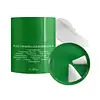What's inside
What's inside
 Key Ingredients
Key Ingredients

 Benefits
Benefits

 Concerns
Concerns

 Ingredients Side-by-side
Ingredients Side-by-side

Ethylhexyl Palmitate
EmollientPolyethylene
AbrasivePEG-20 Glyceryl Triisostearate
EmollientButyrospermum Parkii Butter
Skin ConditioningPhenoxyethanol
PreservativePEG-30 Dipolyhydroxystearate
EmulsifyingSimmondsia Chinensis Seed Oil
EmollientCaprylyl Glycol
EmollientTocopherol
AntioxidantPolysorbate 20
EmulsifyingOctyldodecanol
EmollientPPG-26-Buteth-26
Skin ConditioningTrihydroxystearin
Skin ConditioningCI 42090
Cosmetic ColorantPEG-40 Hydrogenated Castor Oil
EmulsifyingCI 19140
Cosmetic ColorantWater
Skin ConditioningSodium Hyaluronate
HumectantGlucomannan
Skin ConditioningCitric Acid
BufferingEthylhexyl Palmitate, Polyethylene, PEG-20 Glyceryl Triisostearate, Butyrospermum Parkii Butter, Phenoxyethanol, PEG-30 Dipolyhydroxystearate, Simmondsia Chinensis Seed Oil, Caprylyl Glycol, Tocopherol, Polysorbate 20, Octyldodecanol, PPG-26-Buteth-26, Trihydroxystearin, CI 42090, PEG-40 Hydrogenated Castor Oil, CI 19140, Water, Sodium Hyaluronate, Glucomannan, Citric Acid
 Reviews
Reviews

Ingredients Explained
These ingredients are found in both products.
Ingredients higher up in an ingredient list are typically present in a larger amount.
Caprylyl Glycol is a humectant and emollient, meaning it attracts and preserves moisture.
It is a common ingredient in many products, especially those designed to hydrate skin. The primary benefits are retaining moisture, skin softening, and promoting a healthy skin barrier.
Though Caprylyl Glycol is an alcohol derived from fatty acids, it is not the kind that can dry out skin.
This ingredient is also used as a preservative to extend the life of products. It has slight antimicrobial properties.
Learn more about Caprylyl GlycolPeg-20 Glyceryl Triisostearate comes from Isostearic Acid and glycerin.
It is an emollient, emulsifier, and gentle cleanser. As an emollient, it helps trap moisture to keep skin soft and hydrated. Emulsifiers help prevent ingredients from separating.
This ingredient is common in oil-based products. This is because it helps oil-ingredients be easily washed away without leaving a residue.
Peg-20 Glyceryl Triisostearate may not be fungal-acne safe.
Learn more about PEG-20 Glyceryl TriisostearateWater. It's the most common cosmetic ingredient of all. You'll usually see it at the top of ingredient lists, meaning that it makes up the largest part of the product.
So why is it so popular? Water most often acts as a solvent - this means that it helps dissolve other ingredients into the formulation.
You'll also recognize water as that liquid we all need to stay alive. If you see this, drink a glass of water. Stay hydrated!
Learn more about Water